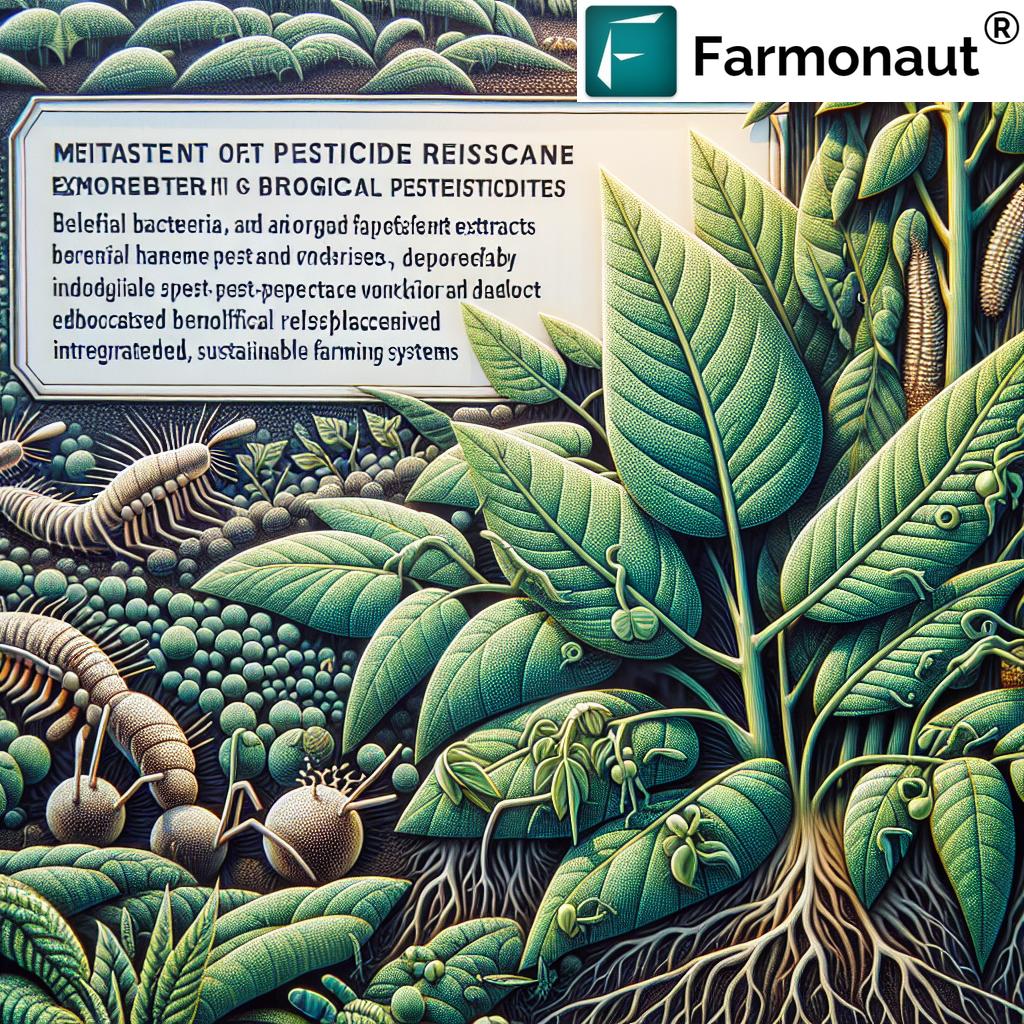Farming Biologicals: 7 Ways to Boost Yields
“Biologicals can increase crop yields by up to 20% while reducing chemical fertilizer use by 30%.”
Introduction: Unveiling Agricultural Biologicals
Agricultural biologicals represent a paradigm shift toward sustainable farming practices, offering natural alternatives to chemical inputs for farmers, researchers, and agribusinesses worldwide. Harnessed from living organisms, such as bacteria, fungi, plant extracts, and natural byproducts, these biological products are meticulously developed to enhance crop productivity, improve soil health, and efficiently manage pests and diseases. Their rise is closely tied to the global push for eco-friendly agricultural practices that prioritize environmental sustainability, reduced pollution, and increased biodiversity.
In this comprehensive guide, we delve into the fundamental categories of agricultural biologicals, outline their distinct functions, and offer a detailed exploration of seven ways they can boost crop yields while building resilient, healthier farming systems. Supported by key statistics, actionable insights, and the latest technological advances (including farming solutions like those provided by Farmonaut), we provide a practical framework for implementing biologicals on your farm.
Whether you’re a seasoned grower, extension professional, or a new-age agri-entrepreneur, understanding biologicals is pivotal for building sustainability and ensuring future productivity in agriculture.
Categories of Agricultural Biologicals
Agricultural biologicals encompass several distinct categories, each with specialized functions that serve the unique needs of modern farms. These categories are designed to deliver benefits across soil fertility, crop protection, growth enhancement, and environmental management.
-
Biopesticides for pest control: Derived from beneficial bacteria (e.g., Bacillus thuringiensis), fungi, and plant extracts (like neem oil), biopesticides provide minimal-impact, targeted pest management by disrupting the life cycles of insects and pathogens. Their natural origin ensures environmentally friendly control with lower toxicity to non-target organisms.
(Source: Wikipedia: Biopesticide) -
Biofertilizers for soil health: These utilize beneficial microorganisms—notably Rhizobium bacteria, Azospirillum, and mycorrhizae—to fix nitrogen, solubilize phosphorus, and enhance nutrient availability. Biofertilizers not only reduce reliance on synthetic fertilizers but also improve soil structure and crop resilience.
(Source: Agriboom: Biologicals) -
Biostimulants for plant growth: These are non-nutrient substances or microorganisms—such as seaweed extracts, humic substances, amino acids, and microbial agents—that are applied to plants or soil. They stimulate natural physiological processes, resulting in improved nutrient uptake, stress tolerance (e.g., drought, salinity), and overall crop quality.
(Source: ROI Biologicals: Biostimulants)
Additionally, products such as microbial inoculants and organic soil amendments complement these main categories and are increasingly included as vital components of holistic agricultural biological packages.
Comparative Benefits Table: Biologicals at a Glance
| Biological Method | Estimated Yield Increase (%) | Soil Health Improvement (Low/Medium/High) |
Pest Reduction Efficiency (%) | Environmental Impact (Low/Medium/High) |
Adoption Cost (USD/acre) |
|---|---|---|---|---|---|
| Biofertilizers | 10–18% | High | 15–25% | Low | $7–$18 |
| Biopesticides | 7–14% | Medium | 50–90% | Low | $13–$29 |
| Biostimulants | 8–16% | Medium–High | 10–20% | Low | $10–$24 |
| Microbial Inoculants | 12–20% | High | 20–30% | Low | $14–$22 |
| Organic Soil Amendments | 6–12% | High | 10–18% | Low | $12–$28 |
Note: Actual percentage and cost values may vary based on crop, climate, and application methods. This table offers a quick overview for strategic comparison of biologicals for sustainable, eco-friendly farming.
“Over 60% of farmers using biofertilizers report improved soil health and reduced environmental impact.”
Farming Biologicals: 7 Ways to Boost Yields
Let’s dive deeper into seven high-impact strategies—each rooted in biological innovation—that enable improving crop yields sustainably, revitalizing soil health, and enhancing farm profitability while supporting the environment.
1. Biofertilizers for Soil Health and Sustainable Nutrition
Biofertilizers for soil health are foundational for replacing or reducing synthetic fertilizers. These beneficial microorganisms—like Rhizobium for legumes, Azotobacter for cereals, and various phosphate-solubilizing bacteria—are specially applied to soil or seeds to:
- Fix atmospheric nitrogen (making it available to plants naturally)
- Increase nutrient availability and uptake
- Promote root growth and soil structure improvement
- Reduce the need for chemical inputs, aligning with sustainable farming values
Studies show the role of biofertilizers in enhancing yields by 10-18% while revitalizing soil fertility and microbial diversity. This method also aids in breaking the cycle of over-reliance on chemical fertilizers.
Examples: Rhizobium (legumes), Azospirillum (grasses), phosphate-solubilizing bacteria, and mycorrhizal fungi.
Key takeaway: Biofertilizers offer a cost-effective, environmentally friendly solution to promote sustainable soil health.
Explore carbon footprinting to track your sustainable fertilizer use
2. Biopesticides for Targeted Pest Control
Biopesticides for pest control are derived from natural sources—including specific strains of Bacillus thuringiensis (Bt), entomopathogenic fungi, neem oil, and plant-based extracts. Their biological effectiveness stems from unique modes of action that:
- Target specific pests or pathogens (such as caterpillars, beetles, mites) without harming beneficial insects
- Minimize residues in food and the environment
- Reduce the emergence of resistance compared to conventional synthetic pesticides
- Integrate smoothly with integrated pest management (IPM) and organic farming systems
Examples: Bt-based bacterial biopesticides target lepidopteran larvae; Trichoderma and Beauveria bassiana for fungal and insect control; neem oil (Azadirachta indica) for a range of pests and diseases.
Benefits: Using biopesticides enables healthier crops, safer food, and directly supports environmental sustainability by reducing chemical pesticide usage. Many governments and certifying agencies worldwide encourage their adoption.
Utilize remote advisory for timely, effective biological pest management
3. Biostimulants for Plant Growth and Stress Tolerance
Biostimulants for plant growth include both natural and microbial products that stimulate physiological processes in plants and soil. Not to be confused with fertilizers, they:
- Boost root growth and improve nutrient uptake
- Enhance plant tolerance to abiotic stresses (such as drought/salinity/extreme heat)
- Improve crop quality parameters—leading to higher market value
- Work synergistically with beneficial microorganisms for crops
Examples: Seaweed extracts (rich in plant hormones), humic acids (from decomposed organic matter), and specialty bacterial inoculants.
Use case: Biostimulants are increasingly applied as an add-on to integrated crop management programs for maximizing yield and resiliency.
Discover digital tools for precision biostimulant application on large-scale farms
4. Microbial Inoculants and Soil Microbial Diversity
Microbial inoculants are specially cultured living microbial products—including bacteria, fungi, and actinomycetes—that are introduced into soil or onto seeds. Their use:
- Enhances soil microbial diversity and activity
- Promotes soil structure and improves nutrient cycling
- Supports plant-root symbioses (e.g., mycorrhizae-facilitated phosphorus uptake)
- Reduces the risk of soil-borne diseases
Impact: Increased soil vitality leads to healthier plants, stronger resilience to infections, and higher productivity.
Implementation tip: Combining microbial inoculants with precision agriculture technologies (such as Farmonaut’s crop health monitoring) allows for site-specific application and optimized performance.
5. Managing Resistance with Diverse Biological Actions
One of the persistent issues in modern pest management is the rapid emergence of resistance among insect and disease populations exposed to conventional chemical pesticides. Agricultural biologicals disrupt this trend by introducing multiple modes of action:
- The use of differently acting bacteria, fungi, and plant extracts reduces the probability of pests evolving resistance
- Biopesticides often target pest development at various stages, offering integrated pest suppression
- Introducing diversity via alternating or mixing biologicals with synthetic products further lowers resistance pressure
Key insight: Reducing pesticide resistance is possible through biological pest management that creates a dynamic, unpredictable environment for pests.
Efficiently manage resources for diverse biological product applications
6. Natural Alternatives to Chemical Inputs
Agricultural biologicals offer a proven pathway for reducing dependence on synthetic chemicals and their associated environmental drawbacks. Using natural substances and beneficial microorganisms instead of traditional chemical inputs results in:
- Lower chemical residues in produce—crucial for food safety and export markets
- Decreased risk of chemical runoff and water pollution
- Greater conservation of beneficial insects and soil microbes
- Alignment with organic certifications and environmentally conscious consumer trends
Examples include the use of neem oil, pyrethrum flower extracts, and garlic-based preparations for pest control; or mycorrhizal inoculants for improved plant nutrient uptake.
Utilize blockchain-based traceability to assure produce quality and safety
7. Leveraging Technology: Precision Application & Monitoring
Recent advances in digital and remote sensing technologies—such as those pioneered by Farmonaut—have unlocked new ways to maximize the efficacy and consistency of biological applications:
- Satellite-based crop health monitoring allows site-specific, need-based application of biologicals, avoiding under or overuse
- AI-driven advisory platforms (such as Jeevn AI) deliver tailored recommendations for biological inputs and timing, optimizing crop outcomes
- Blockchain traceability assures transparency and trust in the source and history of all biological and chemical inputs used on crops
- Resource management tools help schedule and deploy biological application across fleet and labor resources for efficiency
Access the Farmonaut Satellite & Weather API for automated precision agriculture workflows or browse our developer docs to build your agri solution.
Leverage satellite-based farm verification for crop loans and insurance
Environmental Sustainability: Reducing Impact and Enhancing Biodiversity
Sustainable farming practices lie at the heart of the agricultural biologicals movement. By reducing dependence on chemical pesticides and fertilizers, these natural products offer a direct route to:
- Mitigating environmental pollution: Biopesticides and biofertilizers minimize contaminant runoff and contribute to cleaner water and air
- Promoting biodiversity: The minimal non-target toxicity of biologicals helps conserve pollinators, soil fauna, and beneficial insects
- Enhancing soil carbon sequestration: Bio-based amendments increase soil organic carbon, a key metric for carbon foot-printing and climate-friendly agriculture
- Supporting global sustainability goals set by governments and organizations worldwide
Farmonaut enables farms to monitor their carbon footprint in real-time—a crucial factor in eco-labeling and environmental reporting.
Challenges, Considerations, and the Future of Agricultural Biologicals
Despite remarkable benefits, there are important challenges and adoption barriers to wide-scale implementation of agricultural biologicals:
- Farmer Education & Extension: Adoption is sometimes limited due to a lack of awareness and access to clear, practical information about biological alternatives. Extension programs and digital platforms are needed to bridge this gap.
- Regulatory Hurdles: Approval pathways for new biological products vary substantially by country, presenting regulatory and commercial barriers.
- Efficacy and Consistency: Performance of biologicals can vary with climate, soil type, and crop. Ongoing research and development is necessary to boost reliability and consistency in the field.
Future Market Outlook: The global agricultural biologicals market is forecasted to triple in value—approaching $27 billion by 2028 (see Bayer report). Investment in research, regulatory harmonization, and digital integrations will further strengthen biological crop management solutions.
Technological integration—including satellite-based crop monitoring and AI-powered advisory systems—will be essential for unlocking the full yield and sustainability potential of biologicals.
Farmonaut: Technologies Empowering Sustainable Biological Adoption
Farmonaut is a pioneering agricultural technology company committed to making precision agriculture accessible, effective, and sustainable for farmers and agribusinesses globally. Through our advanced, satellite-based farm management solutions—with Android, iOS, web, and API access—we empower users to monitor crop health, manage inputs, and drive sustainability using the latest in agricultural technology.
Our Key Technologies Include:
- Satellite-Based Crop Health Monitoring: Real-time NDVI, soil moisture, and vegetation analysis to guide informed biological input decisions.
- Jeevn AI Advisory System: Personalized, AI-driven crop management advisory—enabling more precise use of biologicals and chemical inputs for maximum crop productivity with minimum waste.
- Blockchain Traceability: Secure, transparent, and verifiable tracking of biological products and crop origins, helping our users assure quality and food safety to end consumers. Learn how traceability bolsters trust and compliance.
- Resource & Fleet Management: Efficiently coordinate the deployment of biological products and application machinery across large hectares and multiple fields. Optimize resources for greater sustainability.
- Carbon Footprinting: Track and minimize your operation’s environmental impact, supporting both sustainability certifications and internal improvement goals. See how our carbon tracking works.
Our platform is mobile responsive and scalable, serving everyone—from individual farmers and cooperatives to agribusinesses and governments. We deliver actionable insights so that you can adopt the right mix of biological and conventional solutions, monitor outcomes, and grow more profitably.
Experience Farmonaut crop health monitoring in action on your farm today
Farmonaut Subscription Plans
We offer flexible, affordable precision agriculture subscriptions to fit your operation’s size and needs—all accessible from your web browser or mobile device.
For integration needs, visit our API developer documentation.
FAQs on Agricultural Biologicals
-
What are agricultural biologicals?
They are naturally derived products—such as biofertilizers, biopesticides, and biostimulants—utilized to improve soil health, enhance crop yields, and manage pests while reducing reliance on synthetic chemicals. -
Are biologicals as effective as chemical inputs?
When properly selected and applied, many biologicals offer equivalent or superior productivity and environmental benefits compared to traditional chemical inputs. -
What is the difference between biofertilizers, biopesticides, and biostimulants?
Biofertilizers supply nutrients via living microbes; biopesticides offer natural pest and disease control; biostimulants stimulate plant growth and help mitigate abiotic stress. -
How can I implement biologicals on my farm?
Start by identifying your soil, crop, and pest management needs. Use precision agriculture platforms (like Farmonaut) to monitor outcomes and adjust applications accordingly. -
Are agricultural biologicals suitable for all crops?
Most field, vegetable, and orchard crops can benefit from agricultural biologicals, but choosing the right product, timing, and method of application is essential.
Conclusion
Agricultural biologicals are a catalyst for a new era of sustainable farming—shifting the industry from chemical-intensive to nature-inspired, environmentally conscious practices. With increasing market adoption, technological support, and ongoing research, these natural products are poised to revolutionize crop productivity, soil health, and environmental stewardship.
Whether your objective is improving yield sustainably, reducing input costs, accessing new markets, or meeting environmental obligations, biologicals offer an actionable, future-ready solution. By leveraging digital tools and precision monitoring—such as those offered by Farmonaut—you can harness the best blend of biologicals and technology to secure a resilient agricultural future.
Join the movement towards healthier soils, safer food, and vibrant ecosystems—let’s farm smarter with biologicals!













